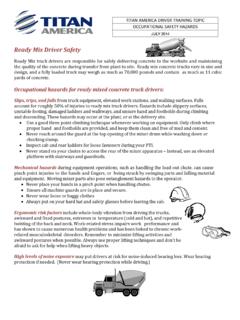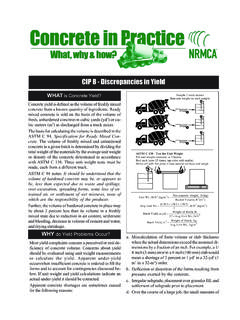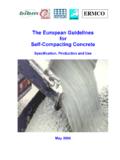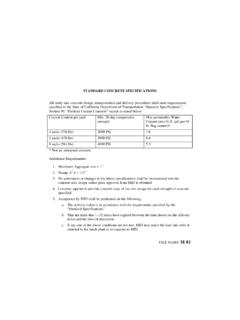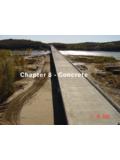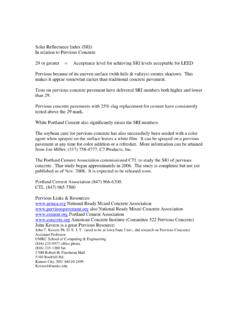Transcription of Stormwater Best Management Practice Concrete Washout
1 Stormwater best Management Practice Concrete Washout Figure 1. Chute Minimum Measure washwater being dumped on the ground Construction Site Stormwater Runoff Control Subcategory Good Housekeeping/Materials Management Description of Concrete Washout at Construction Sites Concrete and its ingredients Concrete is a mixture of cement, water, and aggregate material. Figure 2. Chute Portland cement is made by heating a mixture of limestone and washwater leaking from a clay containing oxides of calcium, aluminum, silicon and other roll-off bin being used as a metals in a kiln and then pulverizing the resulting clinker. The Washout container fine aggregate particles are usually sand. Coarse aggregate is generally gravel or crushed stone. When cement is mixed Construction workers should handle wet Concrete and with water, a chemical reaction called hydration occurs, which Washout water with care because it may cause skin irritation produces glue that binds the aggregates together to make and eye damage.
2 If the washwater is dumped on the ground Concrete . (Fig. 1), it can run off the construction site to adjoining roads and enter roadside storm drains, which discharge to surface Concrete Washout waters such as rivers, lakes, or estuaries. The red arrow in After Concrete is poured at a construction site, the chutes of Figure 2 points to a ready mixed truck chute that's being ready mixed Concrete trucks and hoppers of Concrete pump washed out into a roll-off bin, which isn't water type. This trucks must be washed out to remove the remaining Concrete washwater, shown in the foreground, will likely follow similar before it hardens. Equipment such as wheelbarrows and hand paths to nearby surface waters. Rainfall may cause Concrete tools also need to be washed down. At the end of each work Washout containers that are uncovered to overflow and day, the drums of Concrete trucks must be washed out.
3 This is transport the washwater to surface waters. Rainwater polluted customarily done at the ready mixed batch plants, which are with Concrete washwater can also percolate down through usually off-site facilities, however large or rural construction the soil and alter the soil chemistry, inhibit plant growth, and projects may have on-site batch plants. Cementitious (having contaminate the groundwater. Its high pH can increase the the properties of cement) washwater and solids also come from toxicity of other substances in the surface waters and soils. using such construction materials as mortar, plaster, stucco, Figures 1 and 2 illustrate the need for better Management and grout. practices . Environmental and Human Health Impacts best Management Practice Objectives Concrete Washout water (or washwater) is a slurry containing The best Management Practice objectives for Concrete Washout toxic metals.
4 It's also caustic and corrosive, having a pH are to (a) collect and retain all the Concrete Washout water and near 12. In comparison, Drano liquid drain cleaner has a pH solids in leak proof containers, so that this caustic material of Caustic washwater can harm fish gills and eyes and does not reach the soil surface and then migrate to surface interfere with reproduction. The safe pH ranges for aquatic life waters or into the ground water, and (b) recycle 100 percent habitats are 9 for freshwater and for saltwater. of the collected Concrete Washout water and solids. Another Office of Water, 4230M EPA 833-F-11-006. September 2011. Stormwater best Management Practice : Concrete Washout objective is to support the diversion of recyclable materials from contacted to inquire landfills. Table 1 shows how Concrete Washout materials can be about any pretreatment recycled and reused.
5 Requirements, , the National Pretreatment Table 1 Recycling Concrete Washout materials Standards for Prohibited Concrete Washout Materials Dischargers (40 CFR ), before discharging the Unused wet Washwater aggregate aggregate Hardened Concrete Concrete washwater to the POTW. Cement Coarse finesa The washwater can also Fine Uses of Recycled Materials Figure 4. Vacuuming washwater out of a Reused to Washout additional mixer be retained in the Washout Washout container for treatment and reuse x truck chutes or drums container and allowed to Reused as a ready mixed Concrete evaporate, leaving only the hardened cementitious solids to be x xb x x ingredient recycled. Reused as an ingredient of precast Concrete products, , highway x x x x x barriers, retaining wall blocks, riprap Solids recycling Reused as crushed Concrete x x x x The course aggregate materials that are washed off Concrete products, , road base or fill Reused to pave the yards of ready truck chutes into a Washout container can be either separated x mixed Concrete plants by a screen and placed in aggregate bins to be reused at Returned back to a surface water, the construction site or returned to the ready mixed plant and xc , river, lake, or estuary a.
6 Fine particles of cementitious material ( , Portland cement, slag cement, fly ash, washed into a reclaimer (Fig. 5). When washed out into a silica fume) reclaimer, the fine and course aggregates are separated out b. Recyclable, if allowed by the Concrete quality specifications and placed in different c. Treated to reduce the pH and remove metals, so it can be delivered to a municipal wastewater treatment plant, where it is treated further and then returned to a natural piles or bins to be reused surface water in making fresh Concrete . Reclaimers with settling Washwater recycling, treatment, disposal tanks separate cement Washwater from Concrete truck fines from the washwater, chutes, hand mixers, or other and these fines can also equipment can be passed through be used in new Concrete a system of weirs or filters to remove unless prohibited by the solids and then be reused to wash Figure 5.
7 ready mixed truck washing user's Concrete quality out into a reclaimer down more chutes and equipment specifications. at the construction site or as an ingredient for making additional Hardened Concrete recycling Concrete . A three chamber Washout When the washwater in a construction site Concrete Washout filter is shown in Figure 3. The first container has been removed or allowed to evaporate, the stage collects the coarse aggregate. hardened Concrete that remains can be crushed (Fig. 6). The middle stage filters out the Figure 3. Concrete Washout filter and reused as a construction material. It makes an excellent small grit and sand. The third stage aggregate for road base and can be used as fill at the has an array of tablets that filter construction site or out fines and reduces the pH. The filtered washwater is then delivered to a recycler.
8 Discharged through a filter sock. An alternative is to pump the Concrete recyclers can Washout water out of the Washout container (Fig 4) and treat be found at municipal the washwater off site to remove metals and reduce its pH, solid waste disposal so it can be delivered to a publicly owned treatment works facilities, private (POTW), also known as a municipal wastewater treatment plant, Figure 6. Crushed Concrete stockpile and recycling plants, or large which provides additional treatment allowing the washwater crusher construction sites. to be discharged to a surface water. The POTW should be 2. Stormwater best Management Practice : Concrete Washout Wet Concrete recycling driver then washes down Builders often order a little more ready mixed Concrete than the chute into the bucket to they actually need, so it is common for Concrete trucks to remove any cementitious have wet Concrete remaining in their drum after a delivery.
9 This material before it hardens. unused Concrete can be returned to the ready mixed plant and After washing out the chute, either (1) used to pour precast Concrete products ( , highway the driver pumps (yellow barriers, retaining wall blocks, riprap), (2) used to pave the arrow points to the pump). ready mixed plant's yard, (3) washed into a reclaimer, or the washwater, sand, and other fine solids from the Figure 8. Chute Washout bucket and (4) dumped on an impervious surface and allowed to harden, pump so it can be crushed and recycled as aggregate. Unused wet bucket up into the truck's Concrete should not be dumped on bare ground to harden at drum to be returned to the construction sites because this can contribute to ground water ready mixed plant, where it can be washed into a reclaimer. and surface water contamination.
10 A removable screen at the bottom of the Washout bucket prevents course aggregate from entering the pump. This course aggregate can also be returned to the plant and added Washout Containers to the coarse aggregate pile to be reused. All the materials are Different types of Washout containers are available for recycled. collecting, retaining, and recycling the washwater and solids from washing down mixed truck chutes and pump truck Hay bale and plastic Washout pit hoppers at construction sites. A Washout pit made with hay bales and a plastic lining is shown in Figure 9. Such pits can be dug into the ground or built above Chute Washout box grade. The plastic lining should be free of tears or holes that A chute Washout box is mounted on the back of the ready would allow the washwater to escape (Fig. 10). After the pit is mixed truck.
